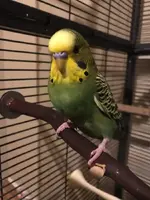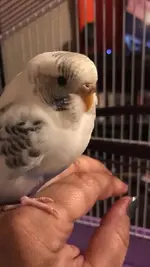It depends on the bird as far as the length of the breeding-season goes, it is the season for hormones right now, so it's normal for the female to be in-season right now, but being housed with a male that she is closely-bonded to makes it worse. It may be a while before she comes out of it, and she'll be able to tell because her cere will change back from the really crusty, scabby dark brown to again being smooth and either light tan/creamy or blue with white rings around the nostrils, whatever color her cere normally is/was.
No, she can't put them back together, because even if the female isn't in breeding-season they will still mate and lay fertile eggs. Once an opposite-sex pair of birds is closely-bonded to each other, they are likely going to start mating, and what would probably happen is that as soon as she put them back together, the female would just go right back into breeding-season anyway...So they need to stay in their own, separate cages from now on. But again, they can be let out together as long as she watches them the entire time and stops any mating...
As far as the egg-food goes, just give the female a very small dish of it, it will take her a while to eat it all (do not only feed her the egg-food)...If the female does lay an egg, then she needs to continue to feed the egg-food, because she'll be laying more than just one egg, it could be a bunch, and she needs the calcium. I'd let her eat one small dish of the egg food for now, and then stop it unless she does lay an egg. If she lays an egg then she'll need to have a small dish of it in with her until she's done laying them. It's actually more important that she ALWAYS have a Cuttlebone and a Mineral Block inside of her cage at all times, as these are constant sources of Calcium and Phosphorous that female birds need all the time anyway, and especially if they are laying eggs or going to lay eggs, or have just finished laying eggs...And the Cuttlebone and Mineral Block aren't high in calories/fat like the egg-food is. So if she doesn't have both a Cuttlebone and Mineral Block, that's a priority. Actually, her male should have at least a Cuttlebone too. It's good for their beaks, their toenails, etc. And it gives them something to file their beaks on as well. You can buy a Cuttlebone at any grocery store or Walmart for like $1, and Petco sells a couple different Mineral Blocks for a couple dollars, one that is pink and looks like a Strawberry, and one that is Yellow and shaped like a big flower. Either is fine.
As far as them being "fat", lol, it's probably due to the fact that they eat a seed-mix as the staple of their diet instead of a pellet, as seed-mixes are much higher in fat, especially Budgie seed-mixes that are mostly different types of millet seeds. Also, if they don't come out of their cages and get to fly around each day for a bit, then they aren't getting any exercise, and that's what happens...However, I wouldn't at all call them "fat" or even overweight judging from the photos you posted, they look healthy...
She needs to keep in mind that if her female bird does start laying eggs, she's going to naturally start losing weight as well as Calcium, and sometimes they actually become quite skinny. That's when the egg-food comes into play, because it will provide her with extra calories and fat in addition to the extra calcium. Some females who become chronic egg-layers, just laying egg after egg after egg and clutch after clutch, will actually become emaciated and anemic due to the amount of energy, calories, calcium, etc. it takes their bodies to make eggs. So it's much better while she's in Breeding-Season that she be on the heavy side than the thin side...But they both look healthy to me from those photos...


